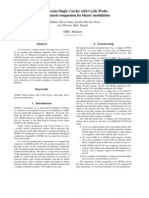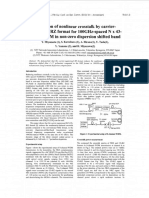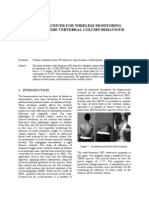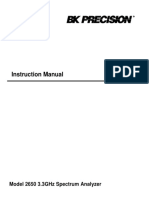Modulation: RZ-DQPSK Format Efficiency Towards
Modulation: RZ-DQPSK Format Efficiency Towards
Uploaded by
Hank ChenOriginal Description:
Original Title
Copyright
Available Formats
Share this document
Did you find this document useful?
Is this content inappropriate?
Report this DocumentCopyright:
Available Formats
Modulation: RZ-DQPSK Format Efficiency Towards
Modulation: RZ-DQPSK Format Efficiency Towards
Uploaded by
Hank ChenCopyright:
Available Formats
Modulation Format 1 9.6.
6
RZ-DQPSK FORMAT WITH HIGH SPECTRAL EFFICIENCY AND HIGH ROBUSTNESS TOWARDS FIBER NONLINEARITIES
Christoph Wree; Jochen Leibrich; Werner Rosenkranz Chair for Communications, University of Kiel, Kaiserstr. 2, 24143 Kiel, Germany (cw(&f.uni-kiel.des
Abstract We propose a simple concept to implement a direct-detection DQPSK transmission to double the transmission rate, The robustness of RZ-DQPSK towards nonhinearities is Investigated in a 8x800bIs WDMsystem over 400km SSMF and compaed to 8x40GbIs RZ-ASK.
Introduction Recently, dfferential binary phase-shift-keying (DBPSK) with return to zero pulse shape (RZ) has been considered as an advantageous modulation format in optical transmission systems to achieve a higher robustness towards nonlinear effects (1.2]. In this work, we propose a simple concept to extend CFRZ-DPSK to differential quadrature PSK (RZ-DQPSK) to Increase the spectral efficiency by a factor of two. RZ-DQPSK transmission Is Implemented by means of an additional sequential phase modulator and two binary DPSK balanced receivers in parallel. The performance of Sx8OGbis RZ-DQPSK Is compared to 8x4OGb/s conventional On/Off-Keying with RZ pulse shape (RZ-ASK) both at a channel spacing of 1OOGHz over 400km dispersion compensated SSMF.
Proposal for RZ-DQPSK direct dotection In most DQPSK systems In classical digital communications the four-symbol signal Is generated by superposing two bipolar modulated carrier frequencies that exhibit the same frequency but have a 90g phase shift to each other [4]. It Is difficult to adapt this concept to optical communications because the required phase shit of 90* has to be guaranteed until the signals are merged by a 3dB coupler, In a recent optical DQPSK proposal (3] this problem Is overcome by OtE converting part of the transmitter signal and feeding it to a servo-control loop. We avoid this problem by a DQPSK transmitter setup shown in fig. 1.
(CWih,
MZM
(GVD). Fig. I also shows that for transmitting RZDQPSK with a bit rate of 80Gb/s the electronic components only have to operate at the symbol rate of 40GSymbts. The dfferential QPSK precoder [4] is necessary in order to use the simple receiver (3] in fig. 2b) with an optical filer (delay line Ts= 2 x bit duration) and two balanced receivers.
di
.
4-0
I)~~~~b
TOd
real1 ...f1) I
Fig. 2: a) Trajectones of RZ-OQPSK signal constellation In complex plane, b) DQPSK recetver
NIR.DPSJR
NUM
7t.DOW PM RZ-DQPS
Experimental verification at 2OGbls For experimental use at 2OGb/s, we implemented the transmitter acoording to fig. 1. For the receiver, the optical filter was realized by means of spliced fiber couplers. The length of the arms are chosen carefully via temperature control. For 2OGbJs BER measurements without precoder. the pulse pattern generator was programmed with a 27-1 data sequence that allowed to receive the expected sequence with the bit error tester. We achieve error free transmission in each arm. The measured eye diagram In the upper receiver arm for 20Gb/s is shown in fia. 3.
at4('hiR$4t _ I- i .140%4ls tt
Fig. 1: Transmission setup for RZ-DQPSK The first two Mach-Zehnder modulators (MZM) form a chirp-free binary DPSK signal with RZ pulse shape (CF-RZ-DPSK [21). The subsequent phase modulator (PM) with a phase shift of either 90 (d1=1) or 0 (d,=0) generates four symbols out of the binary PSK signal, see fig. 2a). This concept requires only electrical tuning of the PM input data within a bit duration by a delay compensation. Fig. 2a) shows that the signal has almost no power during bit transitions and Is thus inherently chirp free. This Is advantageous considering the effect of group velocity dispersion
Fig. 3: Measured RZ-DQPSK eye diagram for 20Gb/s
data rate using single photo diode
Setup The DWDM signal consists of 8 multiplexed channels in RZ-DQPSK and RZ-ASK modulation format with a data rate of 80Gb/s and 40Gb/s per channel, respectively (channel spacing 100Hz, conform to ITU-T G.692). The optical multiplexer is modeled as
Modulation Format 1 9.6.6
an Arrayed-Waveguide Gratlng with a Gaussian shaped transfer function for each channel (B3da=72GHZ). The RZ-DQPSK transmission setup is described in the previous section. The conventional RZ-ASK transmitter consists of two MZM. For RZ-DQPSK and RZ-ASK the 8-channel DWDM signal (PRBS length 21o-1) passes through 4 fiber spans. Each span consists of 100km of a standard single mode fiber followed by a dispersion compensating fiber and a noiseless optical ampifier. The average fiber input power per channel in each span is varied between 0 and 9dBm. The length of the DCF is chosen such that the 40 channel (fl-193ATHz) is fully compensated. At the receiver side a channel selection filter with a bandwidth of 100GHz filters the signal at a center frequency of 1 93ATHz. The DQPSK receiver of fig. 2b) is used with the optical filter, two balanced receivers and an electrical lowpass filter (Butterworth, 3rd order, f3d8=28GHz).
The eye diagrams of the 4OGbIs-RZ-ASK signal and the 80Gbls-RZ-DQPSK signal at 193.4THz and for 6dBm average fiber input power in case of full Kerr nonlinearities are shown in fig. 5 in comparison to the back-to-back eye diagrams.
Results In fig. 4 and 5, we show simulation results that are discussed in the next section. To understand the influence of the various nonlinear effects separately, two types of WDM simulation methods are carried out. The first considers linear crosstalk and full Kerr nonlinearity (SPM, XPM and FWM). For the second, we neglected XPM and FWM in our simulation (2]. In fig. 4, we measure the eye opening penalty (EOP) of the 41h channel for both WDM systems respectively normalized to the back-to-back case as a function of the average fiber input power per channel Ph.
S2
.. ..
Discussion Our simulation results (fig. 4 and 5) indicate that RZDQPSK with a spectral efficiency of 0.8b(slHz tolerates even higher input powers than RZ-ASK with Just 0.4b/slHz spectral efficiency. Fig. 4 shows that in the case of the considered WDMsystem for an EOP of 1dB RZ-DQPSK tolerates approx. 3dB more input power compared to RZ-ASK. This indicates that the advantageous properties of binary DPSK that are shown in e.g. (1.2] can be transferred to (quadrature) RZ-DQPSK. By comparing the simulation methods with (i) full Kerr nonlinearity (solid line) and (ii) neglecting XPM and FWM (dashed line) in fig. 4, it can be noticed that for RZ-ASK and RZ-DOPSK the most important impairment is SPM in agreement with [5]. Nearly no additional degradation through XPM and FWM can be seen. Further simulations indicated, that 80Gb/s RZDQPSK and 40Gb/s RZ-ASK reveal the same amount of dispersion tolerance although the bit-rate is doubled. Comparing on equal bit rate, this means that for the QPSK format the uncompensated length can be quadrupled.
Conclusions We propose an RZ-DQPSK approach to double the
40%M WJMFiWU
_ ..
...
R- I7ARRW
A.
q,l r
n iW, ow
Pq
alw,, ie,r
10
Fig. 4: Eye opening penalty over Pi, for 8x40Gbls-RZASK, 8x80-GbIs-RZ-DQPSIC WDM (uin. Xtalk, SPM, XPM, FWM), WDM without XPM&FWM
!)RZ.OQPSK 6x8OGbWs
b)RZ.ASK 40Gbs
. ^ - - T - OQ~w 347?1-
transmission rate In optical direct detection systems with standard equipment. Compared to RZ-ASK a differential quaternary precoder, a subsequent phase modulator and a simple optical filter in front of two balanced receivers is needed. We could experimentally prove the feasibility of this concept at a data rate of 20Gb/s. By means of RZ-DQPSK, we achieve a spectral efficiency of 0.8Bs/Hz without polarization multiplexing. Our simulations show that in spite of the doubled transmission rate (8x80Gbls) RZDQPSK is even more robust against fiber nonlinearTties than RZ-ASK with just half the bit rate (8x4OGb/s), both having a channel spacing of 100GHz. By means of this It is possible not only to double the transmission rate but also to extend the optical transparent length through Increased robustness towards fiber nonlinearities.
ii qtt
.S
i
.~~~H
Figure 5: Eye opening of a): 8OGbIs-RZ-DQPSK and b): 4OGbls-RZ-ASK, Pk=6dBm, 4OOkm, 100GHz ch.sp., WOM considering tin. Xtalk, SPM, XPM, FWM
References I Gnauck, et al, OFC, Postdeadline FC2, 2002 2 Leibrich, et al, PTL. vol. 14, pp 155-157, 2002 3 Griffin, et at, OFC Postdeadline FD6, 2002 4 Benedetto, et al, Principles of Digital Transmission, Kluwer Academic/ Plenum Publishers, NY, 1999 5 Elbers, et al, Int. J. Electron. Commun. (AEOJ) 55, pp 295-304, 2001
You might also like
- 112 Gb/s DP-QPSK Transmission Using A Novel Nonlinear Compensator in Digital Coherent ReceiverDocument3 pages112 Gb/s DP-QPSK Transmission Using A Novel Nonlinear Compensator in Digital Coherent ReceiverZainab FaydhNo ratings yet
- PMD Tolerant Direct-Detection Optical OFDM SystemDocument2 pagesPMD Tolerant Direct-Detection Optical OFDM SystemZainab FaydhNo ratings yet
- 9.2 A 253mW/Channel 4TX/4RX Pulsed Chirping Phased-Array Radar TRX in 65nm CMOS For X-Band Synthetic - Aperture Radar ImagingDocument3 pages9.2 A 253mW/Channel 4TX/4RX Pulsed Chirping Phased-Array Radar TRX in 65nm CMOS For X-Band Synthetic - Aperture Radar ImagingBalaNo ratings yet
- 40G DQPSK Optical Transmission Technology 2Document18 pages40G DQPSK Optical Transmission Technology 2Giannis LazarouNo ratings yet
- Coherent PM QPSKDocument2 pagesCoherent PM QPSKAditya BvmkNo ratings yet
- Gaussian Minimum Shift KeyingDocument52 pagesGaussian Minimum Shift KeyingMohamed EltahanNo ratings yet
- Transmission of A 213.7-Gb/s Single-Polarization Direct-Detection Optical OFDM Superchannel Over 720-km Standard Single Mode Fiber With EDFA-only AmplificationDocument3 pagesTransmission of A 213.7-Gb/s Single-Polarization Direct-Detection Optical OFDM Superchannel Over 720-km Standard Single Mode Fiber With EDFA-only AmplificationAliAzarniaNo ratings yet
- Simple and Flexible NRZ-DQPSK Demodulation Scheme: Tuaa5 PDFDocument2 pagesSimple and Flexible NRZ-DQPSK Demodulation Scheme: Tuaa5 PDFkenjo138No ratings yet
- A 2GS/s 9-Bit 8-12x Time-Interleaved Pipeline-SAR ADC For A PMCW Radar in 28nm CMOSDocument4 pagesA 2GS/s 9-Bit 8-12x Time-Interleaved Pipeline-SAR ADC For A PMCW Radar in 28nm CMOSburakgonenNo ratings yet
- 1.12-Tbs 32-QAM-OfDM Superchannel With 8.6-BsHz Intrachannel Spectral Efficiency and Space-Division Multiplexing With 60-BsHz Aggregate Spectral EfficiencyDocument3 pages1.12-Tbs 32-QAM-OfDM Superchannel With 8.6-BsHz Intrachannel Spectral Efficiency and Space-Division Multiplexing With 60-BsHz Aggregate Spectral Efficiencymalhiavtarsingh100% (1)
- Performance Analysis and Monitoring of Various Advanced Digital Modulation and Multiplexing Techniques of F.O.C Within and Beyond 400 GBS PDFDocument23 pagesPerformance Analysis and Monitoring of Various Advanced Digital Modulation and Multiplexing Techniques of F.O.C Within and Beyond 400 GBS PDFAIRCC - IJCNCNo ratings yet
- Digital Modulation Techniques For Mobile and Personal Communication SystemsDocument8 pagesDigital Modulation Techniques For Mobile and Personal Communication Systemsdava2007No ratings yet
- Transmission Techniques General Criteria For Modulation Technique SelectionDocument13 pagesTransmission Techniques General Criteria For Modulation Technique SelectionBassel Imad Al AawarNo ratings yet
- High-Speed Transmission by Direct-Detection Opticalofdm: Eft) (N)Document3 pagesHigh-Speed Transmission by Direct-Detection Opticalofdm: Eft) (N)AliAzarniaNo ratings yet
- Digital Modulation Techniques in Mobile Communications: Fahredd'n Sadikoglu 1Document52 pagesDigital Modulation Techniques in Mobile Communications: Fahredd'n Sadikoglu 1Kapil VatsalNo ratings yet
- Direct-Detection Superchannel Using Optical OFDM: Wei-Ren Peng, Hidenori Takahashi, Itsuro Morita, and Takehiro TsuritaniDocument2 pagesDirect-Detection Superchannel Using Optical OFDM: Wei-Ren Peng, Hidenori Takahashi, Itsuro Morita, and Takehiro TsuritaniAliAzarniaNo ratings yet
- Cac Loai Dieu CheDocument52 pagesCac Loai Dieu CheLênh Đênh Trên BiểnNo ratings yet
- Ban Pimrc 2010Document6 pagesBan Pimrc 2010ragaconiNo ratings yet
- OFDM Versus Single Carrier With Cyclic Prefix: A System-Based Comparison For Binary ModulationDocument4 pagesOFDM Versus Single Carrier With Cyclic Prefix: A System-Based Comparison For Binary ModulationKieu HuongNo ratings yet
- Equalized GMSK, Equalized QPSK and OFDM, A Comparative Study For High-Speed Wireless Indoor Data CommunicationsDocument5 pagesEqualized GMSK, Equalized QPSK and OFDM, A Comparative Study For High-Speed Wireless Indoor Data CommunicationsAhmed MidoNo ratings yet
- Novel QPSK Modulation For DWDM Free Space Optical Communication SystemDocument6 pagesNovel QPSK Modulation For DWDM Free Space Optical Communication SystemLương Xuân DẫnNo ratings yet
- 2.7 A Wideband 28GHz Power Amplifier Supporting 8100MHz Carrier Aggregation For 5G in 40nm CMOSDocument3 pages2.7 A Wideband 28GHz Power Amplifier Supporting 8100MHz Carrier Aggregation For 5G in 40nm CMOSCharbel RahmeNo ratings yet
- A 6.1 GS/S 52.8 MW 43 DB DR 80 MHZ Bandwidth 2.4 GHZ RF Bandpass Adc in 40 NM CmosDocument4 pagesA 6.1 GS/S 52.8 MW 43 DB DR 80 MHZ Bandwidth 2.4 GHZ RF Bandpass Adc in 40 NM Cmossohailasghar_tNo ratings yet
- 900 MHZ Digital Spread Spectrum Transceiver: FeaturesDocument13 pages900 MHZ Digital Spread Spectrum Transceiver: FeaturesmgferreyraNo ratings yet
- A Low-Power 60-GHz CMOS Transceiver For WiGig Applications PDFDocument2 pagesA Low-Power 60-GHz CMOS Transceiver For WiGig Applications PDFdanial_1234No ratings yet
- The Design and Performance of SEFDM With The Sinc-to-RRC Modification of Subcarriers SpectrumsDocument5 pagesThe Design and Performance of SEFDM With The Sinc-to-RRC Modification of Subcarriers SpectrumsBui Van ThanhNo ratings yet
- A Survey On Digital Modulation Techniques For Software Defined Radio ApplicationsDocument8 pagesA Survey On Digital Modulation Techniques For Software Defined Radio Applicationssreekanthreddy peramNo ratings yet
- Digital Transmission and Coding Techniques: Return-To-Zero Non-Return To ZeroDocument6 pagesDigital Transmission and Coding Techniques: Return-To-Zero Non-Return To ZeroVibhor BhardwajNo ratings yet
- Design and Comparison of Three 20-Gb/s Backplane Transceivers For Duobinary, PAM4, and NRZ DataDocument14 pagesDesign and Comparison of Three 20-Gb/s Backplane Transceivers For Duobinary, PAM4, and NRZ DataKathir ChandraboseNo ratings yet
- RelatorioDocument9 pagesRelatorioelipe BittarNo ratings yet
- Rayleigh Back-Scattering Reduction by Means of Quantized Feedback Equalization in Wdm-PonsDocument3 pagesRayleigh Back-Scattering Reduction by Means of Quantized Feedback Equalization in Wdm-PonsSy Nam ChuNo ratings yet
- Ijaiem 2014 02 25 039Document4 pagesIjaiem 2014 02 25 039International Journal of Application or Innovation in Engineering & ManagementNo ratings yet
- Modulación de Radio-Sobre-La FibraDocument2 pagesModulación de Radio-Sobre-La FibraJohnJairoArangoQuinteroNo ratings yet
- 300-GHz CMOS Receiver Module With WR-3.4 Waveguide InterfaceDocument4 pages300-GHz CMOS Receiver Module With WR-3.4 Waveguide InterfaceMarcoNo ratings yet
- Academic WritingDocument15 pagesAcademic WritingNursaidatul NajihahNo ratings yet
- Rapid Communication (Namiki Masatoshi)Document13 pagesRapid Communication (Namiki Masatoshi)TerryNo ratings yet
- Direct-Detection 25 GB/S Pon: Pros and Cons of Digital Signal Processing at The Transmitter SideDocument4 pagesDirect-Detection 25 GB/S Pon: Pros and Cons of Digital Signal Processing at The Transmitter SideElsaid SayedAhmedNo ratings yet
- DWDM 100Gb PM-QPSK EvolutionDocument3 pagesDWDM 100Gb PM-QPSK Evolutiongerman.garciaNo ratings yet
- Reduction of Nonlinear Crosstalk by Carrier-Suppressed Format For 1Ooghz-Spaced Gbit/S in Non-Zero Dispersion Shifted BandDocument2 pagesReduction of Nonlinear Crosstalk by Carrier-Suppressed Format For 1Ooghz-Spaced Gbit/S in Non-Zero Dispersion Shifted BandPriyantanuNo ratings yet
- WDM-PON Architecture For Radio Over FiberDocument4 pagesWDM-PON Architecture For Radio Over FiberJohnJairoArangoQuinteroNo ratings yet
- Performance of 20 Gb/s Quaternary Intensity Modulation Based On Binary or Duobinary Modulation in Two Quadratures With Unequal AmplitudesDocument7 pagesPerformance of 20 Gb/s Quaternary Intensity Modulation Based On Binary or Duobinary Modulation in Two Quadratures With Unequal AmplitudesAlejo CrowNo ratings yet
- Spectral Efficiency and Receiver Sensitivity in Direct Detection Optical-OFDMDocument3 pagesSpectral Efficiency and Receiver Sensitivity in Direct Detection Optical-OFDMAliAzarniaNo ratings yet
- A Technique To Improve The Spectral Efficiency by Phase Shift Keying Modulation Technique at 40 Gb/s in DWDM Optical SystemsDocument5 pagesA Technique To Improve The Spectral Efficiency by Phase Shift Keying Modulation Technique at 40 Gb/s in DWDM Optical SystemsUsman TariqNo ratings yet
- An Efficient Technique For Reducing Papr of Ofdm System in The Presence of Nonlinear High Power Amplifier H. Y. Sakran, M. Shokair, and A. A. ElazmDocument9 pagesAn Efficient Technique For Reducing Papr of Ofdm System in The Presence of Nonlinear High Power Amplifier H. Y. Sakran, M. Shokair, and A. A. ElazmKiki DtvtNo ratings yet
- Modulation: Encoding Information in A Baseband Signal and Then Translating (Shifting) Signal To Much Higher Frequency Prior To TransmissionDocument60 pagesModulation: Encoding Information in A Baseband Signal and Then Translating (Shifting) Signal To Much Higher Frequency Prior To TransmissionVamsi KrishnaNo ratings yet
- (1997) An Analysis of Two-Dimensional Pilot-Symbol Assisted Modulation For OFDMDocument4 pages(1997) An Analysis of Two-Dimensional Pilot-Symbol Assisted Modulation For OFDM賴勇先No ratings yet
- PSK Phase-Shift KeyingDocument15 pagesPSK Phase-Shift KeyingfiraszekiNo ratings yet
- Performance of COFDM Using Turbo Codes: Primary Technical Subject Area: Radio CommunicationDocument11 pagesPerformance of COFDM Using Turbo Codes: Primary Technical Subject Area: Radio Communicationmsachemo1No ratings yet
- BER Performance of M-Ary PPM Free-Space Optical Communications With Channel FadingDocument5 pagesBER Performance of M-Ary PPM Free-Space Optical Communications With Channel Fadingfardeen123No ratings yet
- Digital Detection and Feedback Fluxgate MagnetometerDocument7 pagesDigital Detection and Feedback Fluxgate MagnetometerhsongunNo ratings yet
- Costas 2Document4 pagesCostas 2Jean-Hubert DelassaleNo ratings yet
- A 6-b 1-GS/s 30-mW ADC in 90-nm CMOS Technology: Yuan-Ching Lien and Jri Lee National Taiwan University, Taipei, TaiwanDocument4 pagesA 6-b 1-GS/s 30-mW ADC in 90-nm CMOS Technology: Yuan-Ching Lien and Jri Lee National Taiwan University, Taipei, TaiwanSunil PandeyNo ratings yet
- Error Probability of Different Modulation Schemes For OFDM Based WLAN Standard IEEE 802.11aDocument6 pagesError Probability of Different Modulation Schemes For OFDM Based WLAN Standard IEEE 802.11aaboashoorNo ratings yet
- Free Space Optical Communication: Sridhara KDocument4 pagesFree Space Optical Communication: Sridhara KTôm SúNo ratings yet
- Performance Analysis and Monitoring of V PDFDocument23 pagesPerformance Analysis and Monitoring of V PDFIvan CuadrosNo ratings yet
- Blind Paper SpineDocument5 pagesBlind Paper SpineJoao PauloNo ratings yet
- Advanced Multicarrier Technologies for Future Radio Communication: 5G and BeyondFrom EverandAdvanced Multicarrier Technologies for Future Radio Communication: 5G and BeyondNo ratings yet
- ML-TN Xpic Implementation XPD Optimization: Khalil Al-AlamiDocument27 pagesML-TN Xpic Implementation XPD Optimization: Khalil Al-AlamielshokhebyNo ratings yet
- Channel Capacity NotesDocument26 pagesChannel Capacity NotesLOmesh SaHuNo ratings yet
- Mcaffe SIEMDocument63 pagesMcaffe SIEMSpup MsNo ratings yet
- Interface Implementation-9020-7608 IF Guide BC PDFDocument158 pagesInterface Implementation-9020-7608 IF Guide BC PDFbogdan.tomosNo ratings yet
- Cloud Computing Refrence Model CS 8002Document13 pagesCloud Computing Refrence Model CS 8002Vishal JainNo ratings yet
- Z 20ipe 2 (Ir)Document1 pageZ 20ipe 2 (Ir)Noel SalazarNo ratings yet
- Instruction Manual: Model 2650 3.3Ghz Spectrum AnalyzerDocument60 pagesInstruction Manual: Model 2650 3.3Ghz Spectrum AnalyzerИлья ХинкинNo ratings yet
- 3900 Series Base Station LMT User Guide (V100R010C10 05) (PDF) - enDocument279 pages3900 Series Base Station LMT User Guide (V100R010C10 05) (PDF) - enMd Ataulla100% (4)
- ELU76 - 3 MD110 Y ASTERISK - Aastra - Ericsson Systems - Tek-TipsDocument1 pageELU76 - 3 MD110 Y ASTERISK - Aastra - Ericsson Systems - Tek-TipsMorocotoedNo ratings yet
- Catalogo de Antenas SIRA PDFDocument165 pagesCatalogo de Antenas SIRA PDFantonioNo ratings yet
- Group 5 - RA 3396 RA 6849Document62 pagesGroup 5 - RA 3396 RA 6849juanzxc acgNo ratings yet
- Support Engineering Guide (SEG) : Cable: SectionDocument8 pagesSupport Engineering Guide (SEG) : Cable: SectionhenryNo ratings yet
- APS 6.0 Defend Unit 2 UI and Create PGs - 20180823 PDFDocument106 pagesAPS 6.0 Defend Unit 2 UI and Create PGs - 20180823 PDFmasterlinh2008No ratings yet
- Scada - ComponentsDocument32 pagesScada - ComponentsRoni ImronNo ratings yet
- NFV Orchestration - Managing Vnfs in Data Center and BranchDocument26 pagesNFV Orchestration - Managing Vnfs in Data Center and BranchPraveen KumarNo ratings yet
- PLDT Written ReportDocument9 pagesPLDT Written ReportAnthony AlonzoNo ratings yet
- MK12D ManualDocument19 pagesMK12D ManualFabian Borda100% (1)
- Star India InternshipDocument74 pagesStar India InternshipPrasenjit BhadraNo ratings yet
- Configuration Del Arcadis VaricDocument120 pagesConfiguration Del Arcadis Varicvictor Daza100% (1)
- Tait SS TB8100Document4 pagesTait SS TB8100Hugo MendesNo ratings yet
- Day2-02-CCSBA-Deployment and Best Practice-V7.3-169Document55 pagesDay2-02-CCSBA-Deployment and Best Practice-V7.3-169Weis NonidNo ratings yet
- MODULE 2.2 ACTIVITY 08 Ge ElecDocument5 pagesMODULE 2.2 ACTIVITY 08 Ge ElecJinuel PodiotanNo ratings yet
- FortiGate 1000DDocument6 pagesFortiGate 1000DManuel HíjarNo ratings yet
- SGP 23-v1 3Document779 pagesSGP 23-v1 3Pradeep SiriwardanaNo ratings yet
- FinsGateway V2 Manual Embedded EgDocument50 pagesFinsGateway V2 Manual Embedded EgAko Ang SimulaNo ratings yet
- Ruijie RG-AP740-I AP740-I (C) AP720-I) Wireless Access Points Datasheet 2020.6.17Document8 pagesRuijie RG-AP740-I AP740-I (C) AP720-I) Wireless Access Points Datasheet 2020.6.17kanigaraNo ratings yet
- U6 L2 Multichannel Transmission TechniquesRF Over Fiber1Document4 pagesU6 L2 Multichannel Transmission TechniquesRF Over Fiber1Pratiwi Kusumawardani Ji-WeeNo ratings yet
- Nokia UltraSite Support 05.03Document34 pagesNokia UltraSite Support 05.03Rafael AlvarezNo ratings yet
- Threats To E-BusinessDocument24 pagesThreats To E-BusinessskylinecollegeNo ratings yet
- The Need of Public WifiDocument2 pagesThe Need of Public WifiAmsyar HaikalNo ratings yet

























































































